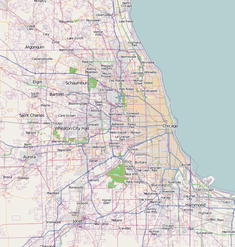
Back Pullman National Monument CEB Pullman National Historical Park German Pullman National Historical Park French
| Pullman National Historical Park | |
|---|---|
 Former Administration Building | |
| Location | Chicago, Illinois, United States |
| Coordinates | 41°41′50″N 87°36′34″W / 41.69722°N 87.60944°W |
| Area | 0.4 acres (0.16 ha) |
| Built | Construction begun in 1880 |
| Architect | Solon Spencer Beman and Nathan F. Barrett |
| Architectural style(s) | Queen Anne, Gothic Revival |
| Governing body | U.S. National Park Service |
| Website | Pullman National Historical Park |
| Designated | February 19, 2015 |
| Official name | Pullman Historic District |
| Designated | October 8, 1969 |
| Reference no. | 69000054 |
| Designated | December 30, 1970 |
| Designated | October 16, 1972 |
Location in Chicago | |
Pullman National Historical Park is a historic district located in Chicago, Illinois, United States, which in the 19th century was the first model, planned industrial community in the United States.[1] The district had its origins in the manufacturing plans and organization of the Pullman Company and became one of the most well-known company towns in the United States, as well as the scene of the violent 1894 Pullman strike. It was built for George Pullman as a place to produce the Pullman railroad-sleeping cars.[2]
Originally built beyond the Chicago city limits, it is in the Pullman community area of Chicago. The district includes the Pullman administration buildings and the company's Hotel Florence, named after George Pullman's daughter, as well as housing originally built for workers and managers. Also within the district is the A. Philip Randolph Pullman Porter Museum, named for the prominent labor and civil rights leader A. Philip Randolph, which recognizes and explores African American labor history.[3] Parts of the site were acquired by the Illinois Historic Preservation Agency prior to being gifted to the federal government.[4][5] Additional grounds remain owned by the state, as the Pullman State Historic Site.[6] The Pullman District, including the national historical park, state historic site, and private homes is east of Cottage Grove Avenue, from East 103rd St. to East 115th St.[7] It was named a Chicago Landmark district on October 16, 1972.[1] It was listed on the National Register of Historic Places on October 8, 1969 and declared a National Historic Landmark on December 30, 1970.[8]
Preservationists had hoped to extend the district to include Schlitz Row, but the taverns located there have been demolished.[9] President Barack Obama named the site a national monument on February 19, 2015, making it a component of the National Park System.[4][10] It was redesignated a National Historical Park in 2022. In celebration of the 2018 Illinois Bicentennial, Pullman was selected as one of the Illinois 200 Great Places[11] by the American Institute of Architects Illinois component and was recognized by USA Today Travel magazine as one of AIA Illinois's selections for Illinois 25 Must See Places.[12]
- ^ a b "Pullman District". City of Chicago Department of Planning and Development, Landmarks Division. 2003. Archived from the original on June 7, 2007. Retrieved May 11, 2007.
- ^ "From factory town to national monument: A brief history of the Pullman Historic District". Chicago Tribune. Archived from the original on May 27, 2019. Retrieved February 19, 2015.
- ^ "A. Philip Randolph Pullman Porter Museum". aphiliprandolphmuseum.com. Archived from the original on January 16, 2013. Retrieved August 4, 2015.
- ^ a b "Presidential Proclamation 9234 - Establishment of the Pullman National Monument". whitehouse.gov. February 19, 2015 – via National Archives.
- ^ "The Town - Hotel Florence". PullmanIL.org. Retrieved May 21, 2014.
- ^ "Pullman History Site". www.pullman-museum.org. Retrieved April 10, 2021.
- ^ Charles W. Snell (February 24, 1970). "National Register of Historic Places Inventory-Nomination: Pullman Historic District" (pdf). National Park Service.
{{cite journal}}: Cite journal requires|journal=(help). Accompanying photos from 1970 and historic images. (6.54 MB) - ^ "Pullman Historic District". National Historic Landmark summary listing. National Park Service. Archived from the original on June 5, 2011. Retrieved October 12, 2007.
- ^ Reardon, Patrick T. and Blair Kamin (January 14, 2003). "The city that wrecks - Developers and the city continue to raze potential landmarks with assembly-line efficiency. A proposed amendment may slow the process, but won't stop it". Chicago Tribune. Retrieved May 23, 2008 – via Newsbank.
- ^ "Obama to make Chicago's Pullman Park a national monument". Washington Post. Retrieved February 11, 2015.
- ^ Waldinger, Mike (January 30, 2018). "The proud history of architecture in Illinois". Springfield Business Journal. Retrieved January 30, 2018.
- ^ "25 Must See Buildings in Illinois". USA Today. August 9, 2017. Retrieved January 30, 2018.


